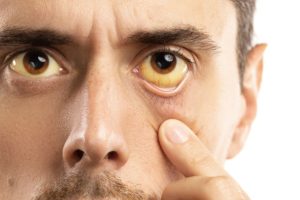
Liver disease can lead to jaundice, which causes the skin and eyes to appear yellow. Jaundice is a result of a build-up of bilirubin in the body. Bilirubin is the byproduct of hemoglobin breakdown in the liver and becomes excreted as bile.
Jaundice isn’t solely caused by liver disease though. It can also be caused by gallstones, pancreatitis, hepatitis, and sickle cell disease.
There are three types of jaundice: pre-hepatic, hepatocellular, and obstructive. Pre-hepatic jaundice is caused by a problem in the blood before it reaches the liver, which in turn releases excess bilirubin. Hepatocellular jaundice is caused by a problem in the liver itself, where the liver cannot work correctly, often as a result of scarring. This leads to bilirubin not being able to be removed. Obstructive jaundice is when the bile ducts become blocked or damaged so that bile cannot be extracted.
It’s essential that you get to the bottom of your cause of jaundice so that the appropriate treatment can be carried out.
Along with yellow skin or eyes, you may also experience pale or light-colored foul-smelling stools, dark yellow or brown urine, itching, abdominal pain, fever, fatigue, change in mental alertness, and blood in vomit or stool.
If you experience yellowing of the skin or eyes along with other symptoms, seek out medical attention right away to get to the bottom of what is going on.